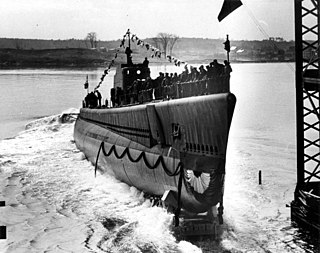
USS Skate (SS-305) was a Balao-class submarine in service with the United States Navy from 1943 to 1946. She was used as a target ship in the 1946 atomic bomb tests and finally sunk as a target ship in October 1948.

USS Sand Lance (SS-381), a Balao-class submarine, was the first ship of the United States Navy to be named for the sand lance, a member of the family Ammodytidae.

USS Greenling (SS-213), a Gato-class submarine, was the first ship of the United States Navy to be named for the greenling.

USS Haddock (SS-231), a Gato-class submarine, was the second submarine of the United States Navy to be named for the haddock, a small edible Atlantic fish related to the cod. A previous submarine had been named Haddock (SS-32), but was renamed K-1 prior to her launching, so Haddock (SS-231) was the first to actually bear the name.

USS Kingfish (SS-234), a Gato-class submarine, was the first ship of the United States Navy to be named for the kingfish.

USS Croaker (SS/SSK/AGSS/IXSS-246), a Gato-class submarine, was the first ship of the United States Navy to be named for the croaker, any of various fishes which make throbbing or drumming noises.

USS Gurnard (SS-254), a Gato-class submarine, was the first ship of the United States Navy to be named for the gurnard.

USS Hoe (SS-258), a Gato-class submarine, was a ship of the United States Navy named for the hoe, one of various sharks, especially the dogfish.

USS Lapon (SS-260), a Gato-class submarine, was the first ship of the United States Navy to be named after the lapon, a scorpionfish of the Pacific coast of the United States.

USS Pargo (SS-264), a Gato-class submarine, was the first ship of the United States Navy to be named for the pargo, a fish of the genus Lutjanus found in the West Indies.

USS Sawfish (SS-276), a Gato-class submarine, was a ship of the United States Navy named for the sawfish, a viviparous ray which has a long flat snout with a row of toothlike structures along each edge. It is found principally in the mouths of tropical American and African rivers.

USS Steelhead (SS-280), a Gato-class submarine, was a ship of the United States Navy named for the steelhead, a North American trout found from California to Alaska.

USS Crevalle (SS/AGSS-291), a Balao-class submarine, was a ship of the United States Navy named for the crevalle, the yellow mackerel, a food fish, found on both coasts of tropical America, and in the Atlantic as far north as Cape Cod.

USS Seahorse (SS-304), a Balao-class submarine, was the first submarine and second ship of the United States Navy to be named for the seahorse, a small fish whose head and the fore part of its body suggest the head and neck of a horse.

The first USS Parche (SS-384/AGSS-384) was a United States Navy submarine. She bore the name of a butterfly fish, Chaetodon capistratus. Parche was a Balao-class submarine that operated in World War II.
USS Kraken (SS-370), a Balao-class submarine, was a ship of the United States Navy named for the kraken, a legendary sea monster believed to haunt the coasts of Norway.

USS Segundo (SS-398) was a Balao-class submarine, of the United States Navy named for the segundo, a cavalla fish of Caribbean waters.

USS Pintado (SS-387/AGSS-387), a Balao-class submarine, was the first ship of the United States Navy to be named for the pintado.

USS Piranha (SS-389/AGSS-389), a Balao-class submarine, was the only ship of the United States Navy to be named for the piranha. Piranha conducted six war patrols during World War II, receiving five battle stars. She was scrapped in 1970.

USS Sea Fox (SS-402), a Balao-class submarine, was a vessel of the United States Navy named for the sea fox, a large shark, also called the thresher shark, which frequents the coast of Europe and the Americas.



















